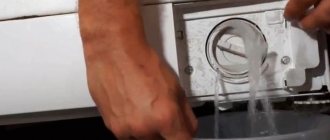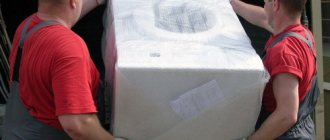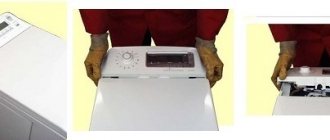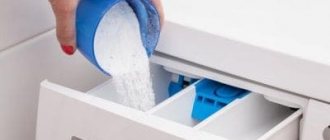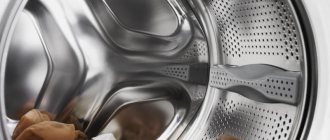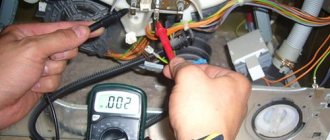Cleaning function: operating features
The process of cleaning laundry is in many ways similar to regular washing. There are several stages in the process:
- Using the pre-wash mode.
- Switch to main mode. First, the wash is done at 60 degrees, at 150 rpm.
- The program ends when using a double rinse, together with a spin, accompanied by maximum speed.
Maintenance monthly cleaning should be enough to prevent serious gaps from forming. It is recommended to remove all debris from the drain tank before using the function.
The use of this mode does not eliminate various formations in the form of scale.
Models of machines with “drum cleaning”
Not all LG washing machines have a “drum cleaning” function. The presence of this function does not affect the price of the unit. Here are examples of budget washing machines with a similar program:
- LG F1048ND is a narrow model with 9 built-in washing programs and 22 additional options, including automatic drum cleaning.
- LG F1280ND5 is also a narrow washing machine with the ability to choose one of 14 programs and 22 additional functions; the machine has a stylish silver design.
- The LG F1280NDS is another slimline washing machine that, in addition to regular washing modes, has the option of steam washing, as well as hypoallergenic washing.
LG drum cleaning function: proper activation
In most models, the function is programmed so that only one button needs to be pressed. What actions need to be taken?
- It is necessary to remove all things and any foreign objects from the drum.
- Next, close the hatch.
- First, the start button is pressed. Next, hold and press the buttons on which the stars are displayed, and at least three seconds should pass. You need to wait until the text tei appears on the panel.
- The function starts when you press the Start button, as in other cases.
- The program usually completes in 1 hour 35 minutes. Afterwards, the drum needs to be dried completely, leaving the hatch open. This completes the cleaning of the drum in the LG washing machine.
It is not recommended to add detergents or cleaning agents during cleaning. Otherwise, a large amount of foam will form and the equipment may freeze.
Cleaning the drum in an LG washing machine
Share on social media networks:
During long-term operation of a washing machine, especially in a large family where the device is used very often, the drum does not always have time to dry. As a result, there is a need to clean it not only from dirt, but also from mold, since a wet and dirty drum becomes an ideal place for the development of bacteria and fungi. Some device models have a drum cleaning system. Today we will introduce you to just such models and tell you how to clean the drum of a Samsung, LG washing machine, and what products are used.
Cleaning: why is the function needed?
Along with the laundry that is loaded into the machine, the following items may get inside washing machines:
- Coins.
- Pins with paper clips.
- Threads.
- Lint particles.
- Fabric fibers.
- Sand particles.
It is necessary to carefully check the things loaded inside to avoid serious damage in the future. Lumps of dirt must be removed. If you are washing a delicate item, you cannot do without using a special bag.
Using dirty water often leads to problems and blockages. The parts inside the machine collect scale due to the salt contained in the metals. An excellent solution for many problems is special compositions and filter substances for liquids. Calgon and Alfagon are one of the acceptable options.
Why do you need to clean your car?
The washing machine is used quite often, the drum does not always dry out from one wash to the next, mold accumulates on it, this place becomes a habitat for bacteria to grow and grow, and an unpleasant odor appears. All this plus soap deposits, dirt from things, which not all goes down the drain, can lead to damage to the washing machine.
In LG equipment, the problem will be solved by the “drum cleaning” program. One idle start for an hour and a half - and particles in the form of sand, fibers, other debris, and plaque will disappear. Sometimes this even has to be done because of coins, pins, paper clips that remain after washing clothes in the unit.
Of course, it is better to carefully check things before putting them in the machine, otherwise foreign objects may cause damage, but if this happens, then you need to wash without clothes to remove them. Cleaning the drum is also necessary in order to refresh the internal cavity from dirt after washing sneakers, rugs and other similar things.
Agree, after that it’s somehow unattractive to immediately wash your underwear or bed linen, even if delicate clothes are placed in special bags. And if the manufacturer decided to add a self-cleaning function to the unit, then this is no coincidence; it needs to be used, and more than once.
What substances can be used for cleaning?
You can use popular recommendations to get rid of dirt if there is no cleaning function. Special chemicals also help, but they must be selected with extreme caution.
Here are just a few acceptable “helpers” in solving the problem:
- Vinegar.
- Soda.
- Lemon acid.
Each option has negative and positive sides.
Application of citric acid
This is the most common product used to remove scale, mold, and traces of grease. It is enough to take 200 grams of dry acid powder to perform one cleaning procedure. When using such tools, the advantages will be as follows:
- Possibility to use automatic drum cleaning mode.
- Safety for constituent components.
- Availability.
- Low cost.
The disadvantage is that citric acid will not be effective if the contamination case is particularly severe. It will be difficult to clean the inside of the device if the drum has not been cleaned for many years. It will be necessary to apply citric acid several times, or choose another method that is more effective.
Using baking soda
Baking soda is suitable for getting rid of dirt accumulated on the walls. But the tank and heating elements will require other methods.
The procedure involves using only 150 grams of the substance.
The method has the following advantages:
- Safety of machine parts.
- Efficient in drum cleaning.
- Availability.
- Low cost.
The disadvantages are that the cleaning process is done manually. In addition, you need to wait a certain time for the soda to interact with water.
Using baking soda requires following the following sequence:
- The walls of the machine are slightly moistened. But you can’t moisten it with plenty of water.
- Pour a little product onto a rag.
- We wait half an hour until the active substances begin to interact with each other.
- Dirt is completely removed with a cloth.
What about vinegar?
This is a concentrated substance that can be used to clean various parts of washing machines. 50 milliliters of the product are diluted with the addition of 150 ml of water. Vinegar essence cannot be used without such dilution.
The cleansing process does not require additional actions from the user. The product has a low price. The procedure is also effective. But vinegar is quite difficult to wash out of the inside of the drum. Rubber parts of cars may be damaged by the substance.
Instructions for inclusion
The drum cleaning program is launched quite simply. For this purpose, it was separately programmed so that it could be turned on by pressing one button. So, to clean the drum, you need:
- check if there are any clothes, linen or foreign objects in the drum of the washing machine; if there are any, remove everything;
- close the drum door;
- turn on the power to the washing machine and open the water supply tap;
- press the “Start” button to turn on the machine;
- hold down the buttons marked “star” for 3 seconds;
- press the “Start” button;
- wait until the end of the program, open the door to dry the drum.
Important! The washing machine manufacturer LG does not recommend using washing powder or descaling products for cleaning. This can lead to the appearance of a large amount of foam and freezing of the equipment.
Use of household chemicals
You can use various means to solve the cleaning problem. Usually this is “Belizna” and other chlorine bleaches, or professional preparations. Chlorine-based products do an excellent job of removing contaminants of any origin. But it is worth remembering that chlorine also negatively affects any parts made of rubber. The substances also have a negative impact on human health.
Procedure for cleaning the washing machine filter
It is important to carry out this procedure carefully, in strict accordance with the rules. It is important not to use excessive force during this procedure so as not to damage the parts of the filling and drainage systems of the washing machine.
Means used
To clean the filter for water coming from the water supply, you will need:
- pliers;
- old toothbrush;
- a little soap solution.
To clean the drain filter, you will need to prepare the following:
- screwdriver;
- pliers;
- a kitchen sponge, which is usually used for washing dishes;
- flashlight;
- shallow container or rag.
It is convenient to clean both nodes during one procedure.
Direct extraction and cleaning
During the cleaning process, you will need to remove the filter and clean it thoroughly. This must be done in accordance with the proposed sequence of actions.
Fill filter
Cleaning the inlet filter is much easier compared to servicing the drain filter.
The work procedure includes the following steps:
- Before you begin, you need to disconnect the machine from the network.
- You need to disconnect the hose through which tap water should flow into the washer.
- It will be convenient to use pliers to remove the filter. It must be remembered that it is a metal mesh.
- The dirt and debris that have accumulated there must be removed from the filter. To do this, it is recommended to use an old toothbrush or something similar. During work, it is prohibited to use any chemical cleaning agents. The only allowed option is a soap solution. In this case, the water should be warm.
- After cleaning is completed, the mesh is thoroughly wiped and put back in place.
- Now you need to put the filter in place.
After completing the procedure, the inlet hose is installed in its original place.
Drain filter
Cleaning the drain drain filter is done as follows:
- Before starting maintenance, the washing machine must be disconnected from the power supply.
- At the bottom of the front wall of the car you can see a small hatch. You need to remove its cover. To do this, you can use a screwdriver by prying it off the edge. To remove this panel, you need to move it slightly to the side or pull it towards you.
- Usually the drain system does not dry out completely. To prevent water from getting on the floor, place a rag under the hole. After the filter is opened, some liquid will spill onto it. Instead of a rag, you can use a small container for water. Some models provide a special hose to remove water in such cases.
- Now you need to unscrew the filter and take it out. On some models, you may need to remove a plug or unscrew a security bolt.
- Now you need to directly start cleaning this unit. First you need to carefully inspect the filter. First of all, various small debris that gets there along with the flowing water are removed from here. In this case, hair, coins, matches, threads or other such objects may come across.
- Next you need to clean off the plaque. To do this, you need to scrub it thoroughly with the hard side of the sponge. Do not use aggressive cleaning agents or hot water for cleaning. Otherwise, it is possible to damage the plastic parts and sealing rubber.
- Next, you need to inspect the hole where the filter was located and thoroughly clean it of debris and dirt. To do this, just wipe it with a soft and damp sponge.
- Now you need to clean the pump and pump. To do this, you will need to shine a flashlight into the hole and remove any dirt found.
- After cleaning is completed, the filter must be carefully put back in place. When tightening it, you need to do this with precise movements in accordance with the location of the thread. Do not apply significant force during installation. Otherwise, the thread may be damaged and the unit will need to be replaced.
- You need to make sure that everything is installed tightly.
After completing the procedure, a check must be carried out. To do this, connect the hose and turn on the washing machine in test mode, without loading laundry. It is necessary to ensure that no water leakage occurs after the maintenance procedure.
Now we need to put the false panel of the small hatch in place. After this, the cleaning procedure will be completed.
If you have difficulty unscrewing
If you cannot unscrew the part with minimal effort, there is no reason to be nervous.
All it takes is a little more effort. If your hand slips, it is enough to use a dry towel or rubber gloves to grab it.
If you still cannot unscrew it, then the most likely reason is that the blockage is very serious. In this case, you need to try to unscrew it even using force. Otherwise, you will have to call a specialist from the service department.
Special means
Frisch Aktiv is a specialized cleaning product developed by specialists from Germany. Thanks to modern technologies, an option has emerged that can be used for cleaning without much harm, even if the procedure is carried out weekly. This solution is effective, and various parts located inside the device do not suffer from such effects.
How to use chemicals?
For a safe and effective cleansing process, it is important to know in advance how to properly use a particular product. “Whiteness”, citric acid or vinegar suggest that the following instructions will help:
- First, the product is poured into the drum.
- We set the standard washing program lasting 1 hour. Temperature regime – not lower than 60 degrees.
- After the wash is completed, the double rinse starts.
- When the device is completed, the machine is left open to dry everything.
As for the Frisch Activ development, its application will be slightly different:
- Half of the cap is placed inside the cuvette.
- The other half is poured directly into the drum.
- At high temperatures, a cold wash starts.
- The scale should soak in the water, along with the product.
- Then the rinse mode starts.
The drum can be called an indicator, which always shows how dirty other parts are. If scale accumulates on the walls of the drum, it means that it is present in large quantities on other surfaces. Therefore, cleaning can be carried out for other parts, including tanks and pulleys, heating elements, rubber hatch cuffs, and drain filters.
Features of the mode
The function will help keep the washing machine clean and avoid mold, and prevent the appearance of unpleasant odors. This is an excellent mode that cleans the inside of the device. Thanks to it, the car can be rid of various insoluble particles, such as sand, wool, fabric residues and other debris.
If you regularly turn on the drum cleaning mode, the housewife will never have to clean the machine from mold, since the device operates at a high temperature (about 60 degrees), and its speed reaches 150 revolutions per minute. This process is step-by-step:
- The first step is to start the pre-wash function.
- After it, the main one is activated, just at this moment the water is heated to 60 degrees, and the rotation speed of the washing machine drum increases.
- The last stage is double rinsing and spinning.
The program runs for almost an hour and a half. It is recommended to turn it on at least once a month.
So how do you clean your drum? Instructions for enabling additional mode:
- Since this program is separate, it is activated with just one button. However, before starting, you need to check the drum for foreign objects, forgotten clothing and debris. Afterwards, close the machine door, turn on the washing machine and press the star button for three seconds. The last action is to click “Start”.
- The program does not require powder or descaling agent; it works “idle”. The manufacturer does not recommend adding any means, as they may cause the device to malfunction.
Regarding pollution prevention
Dampness and high humidity create a favorable environment that promotes the development of mold and fungi. The cause of bacterial growth is debris, dirt and detergent residues that settle on the following parts:
- Rubber based door seal.
- Drain hose.
- Filter.
- The design of the tray where the powder is placed.
Cars also deteriorate from frequent washing of items that have been damaged by contamination from greasy substances.
Limescale is another source of contamination. An insoluble precipitate is formed due to the presence of salts and various impurities in the water. The process of precipitation formation begins when the liquid is heated to a certain temperature. The heating elements become covered with scale, which only increases in size over time. Electricity consumption increases, the heating process does not proceed correctly.
It is recommended to comply with the following requirements and rules for prevention:
- After washing, always leave the hatches open for at least one and a half to two hours.
- Carry out preventive cleaning with vinegar and citric acid. It is enough to use them 1-2 times every 2-3 months.
- Completely flush cleaning agents out of the tray.
- Use the high temperature program at least every week. The main thing is not to set the indicator above 75 degrees, otherwise scale will continue to form.
Experts confirm that the cleaning function makes the machines more reliable. Their condition remains normal for a long time.
Other ways to clean your drum
If there is no drum cleaning function, it is recommended to use proven folk remedies.
- Cleaning with citric acid occurs as follows: 150 g of acid (+ - 50 g) should be poured into the detergent compartment. Then you should set the highest temperature on the long mode and start the wash with an empty drum.
- Using 9% vinegar involves pouring 1 cup of the substance into the detergent compartment. Next, you need to set the highest temperature setting and run a long wash. After mixing vinegar and water, the liquid heats up, at which time it is necessary to pause the wash and leave for 1 hour or more. Then continue the washing cycle until the end of the process, clean the drain filter from accumulated debris and scale, and then leave the hatch open to ventilate the vinegar smell. To avoid damage to parts, do not combine vinegar with other chemicals.
- Soda ash is used as follows: add water 1:1 to the soda powder. Apply the resulting mixture to the drum and rubber gasket on the door. Then, leave for 30 minutes and remove the soda with a sponge. Run the quick wash mode to wash away any remaining dirt.
- Cleaning with chlorine is done by pouring 1 cup of chlorine solution directly into the drum. Next, you need to run a long wash at the highest temperature and with an empty drum.
Advice! Washing machine cleaning products must be used once every 2 months (when washing moderately soiled items twice a week).
Calgon for washing machines can prevent the formation of scale, dirty deposits and fungus in the drum - this is a product consisting of sodium tripolyphosphate and soda. Directions for use: with each wash, add 1/3 to 1 measuring cup to washing powder, depending on the degree of water hardness.
Important! The rubber gasket on the door must also be cleaned of dirt to prevent the formation of mold and mildew. To do this, apply a solution of copper sulfate to the rubber cuffs. After 2 hours, rinse with water and wipe dry.
Which machines support the cleaning function?
LG boasts a wide range of washing machines. But the function we are interested in is not present in every model. The main thing is that the cost does not change much in the presence or absence of such an opportunity.
Description of budget options
- LG F1048ND.
Supports 22 additional functions, together with 9 main programs. A narrow variety of machines, the drum is cleaned automatically.
- LG F1280ND5.
Silver model. Supports 22 additional modes, main programs – 14.
- LG F1280NDS.
The model has small dimensions in width and supports steam and hypoallergenic washing.
Mid-level price category
- LG F-1296ND3.
Supports up to 1200 rpm, additional laundry loading function. Easily supports baby wash and delicate fabrics, removes stains. Prevents additional stains from appearing on clothes.
- FH 2A8HDS4.
Applies to narrow models. Capacity is up to 7 kilograms. There is an inverter motor, which also helps support a large number of modes and functions.
- F-14U2TDH1N.
The machine can easily accommodate up to 8 kilograms of laundry. The device can dry up to 5 kilograms of clothes, in addition to the normal cleaning function. Smart diagnostics is one of the additional useful options.
- F-10B8ND.
Capable of washing up to 1000 per minute when there is up to 6 kilograms of laundry inside. There is additional protection against leaks, together with mobile diagnostics.
Which models have this feature?
The “drum cleaning” option is not available on all models of the brand. To help you choose the right option, we'll tell you about some LG washing machines.
- F1048ND - belongs to narrow models, has 9 programs, including “Quick wash”, “Daily wash” modes and 22 additional functions, including self-cleaning. Holds 6 kg of laundry.
- F1280ND5 - from the same series of narrow machines, the same number of options, but only 14 programs in it. The unit is stylish silver with buttons “Protection against children”, “Protection against leaks”. It is also designed for 6 kg, including washing down products within this limit.
- LG F1280NDS is also a narrow machine. In addition to the usual modes, it has a function for steam cleaning clothes, as well as a hypoallergenic washing mode. Belongs to class A++, which means: economical, consumes little electricity.
All of the above LG models are assembled in Russia and are priced in the budget category. Their average cost is between 20,000 and 25,000 rubles.
Let's consider washing machines of the same brand in the middle price category with drying, steam and self-cleaning functions.
- FH 2A8HDS4 - maximum unit capacity is 7 kg, although the model is compact, its price reaches 35,000 rubles.
- F-14U2TDH1N is a full-size option that can hold up to 8 kg of laundry when washing, and no more than 5 kg when drying. The machine is equipped with Smart diagnostics and has a drum cleaning function. It costs even more – 45,000 rubles.
The drum in these models is adjusted to the “6 care movements” technology, which means that it is capable of washing various types of fabrics, including in gentle and gentle modes.
Separately, we can highlight several more models with a cleaning mode:
- LG F-1296 ND3 – this machine has an “Intelligent Wash” program, mobile diagnostic technology can quickly identify and indicate where a malfunction is detected;
- LG F1003NDP, LG F1203NDP and LG F-10B8ND with a direct drive system, which allows the motor to operate silently, the warranty period for these machines is 10 years.
By the way, according to the manufacturers, the presence of such a mode does not affect the cost of the “automatic machine”. The price is determined from other indicators: the number of functions and programs, the material of manufacture, the number of kilograms of laundry allowed per wash, dimensions and much more.
Of course, if possible, you should choose equipment with self-cleaning; timely activation of the desired mode will remove soap and partially limescale deposits, mold, and wash away dirt from the drum.
But what to do if the machine is unable to clean the drum itself? Here you can use other methods, including folk ones.
Tips for carrying out complex cleanings
Mold, unpleasant odors and dirt are problems that every equipment owner faces. You should regularly maintain the cleanliness of the elements located inside the device.
Washing the drum
Combining disinfectants with idle circulation is one possible solution to this problem. Regular citric acid can also be used. It is recommended to clean the rubber band only by hand.
The simplest processing option requires the following requirements:
- Carefully push the folds apart.
- Wash the cuff around the circumference. We use a sponge, soap, warm water.
- Wipe the surface of the part dry.
A solution of copper sulfate is used if the owner notices the appearance of mold spots. Another acceptable remedy is to prepare a cleaning paste that includes water and baking soda in equal proportions.
The purpose of the composition is to process not only rubber bands, but also the entire drum. The machines are kept in this position for two hours, then we wipe them with a sponge and start the long-term wash mode.
Working with filters and drainage hoses
An unpleasant odor is often caused by dirt particles that remain virtually invisible to the human eye. This is especially true for debris that could not be removed from clothing in time before being placed inside. It is recommended to clean drain filters at least once every three months. If the exploitation is active, then the work is carried out more often.
The operation involves removing the protective panel and a small container into which water flows. You can protect the floor with a cloth. The filter is unscrewed using counterclockwise movements. Then there is washing, with water under high pressure, the accumulated debris is removed from the hole.
When cleaning, the hose is simply disconnected from the parts to which it previously fits. The design and features of the part depend on which specific model of equipment is used by a particular buyer. If there are vertical models, the hose can only be reached using the side cover.
The main reasons for dirt getting into the car
Dirt and foreign objects get not only into the drum, but also into various parts and elements of the washing machine.
Trivial causes of blockages
The reasons for contamination of a Samsung device can be either dirty laundry or poor quality water. For example, dirty laundry can get into the machine:
- Sand.
- Solid dirt particles.
- Threads.
- Pile.
- Foreign objects from pockets (changes, pins, paper clips, etc.).
Important! Along with dirt, grease can settle on the walls of the drum, forming fertile ground for the growth of mold fungi and various bacteria.
Simple preventive measures
To avoid contamination of the machine, the following rules must be observed:
- Be sure to check your clothing pockets before washing and remove all foreign objects from them.
- Before washing, shake off dirt and debris from items.
- Wash delicate and damaged old items in a special bag to protect machine parts from lint and threads.
Technical reasons for tank contamination
However, even if you follow all the washing rules, it is very difficult to protect the device from scale, which settles not only on the inner walls of the drum, but also on the heating element.
Important! Limescale can damage all moving parts of the washing machine.
The main cause of scale deposits is water containing metal salts. This type of water is also called “hard”. Special compounds that should be added before washing will help soften low-quality water.
Important! The most common products are “Calgon” and “Alfagon”.
However, many experts believe that these drugs only harm machine parts, since the chemical compounds they contain destroy the elements of the device over time.
Important! To ensure that household appliances serve for many years, are not covered with scale deposits, and that cleaning the drum of the LG washing machine is required as little as possible, experts recommend using special flow filters that improve the composition of the inlet water.
conclusions
As you can see, there are several reasons for the contamination of such equipment, but in order to protect the device from premature failure, developers of household appliances have equipped their devices with additional options. For example, LG models have a special function: cleaning the drum of an LG washing machine. This mode is designed to maintain hygienic cleanliness not only of the drum, but also of all internal elements of the device.
Important! Regular use of the LG Drum Clean cycle will prevent unpleasant odors and keep your clothes clean and fresh.
How do mineral and lime deposits appear in the machine?
On average, the washing machine runs 2 times a week. A large amount of tap water passes through it, which is most often characterized by increased hardness and the admixture of many foreign particles.
For example, we can recall the operation of a conventional electric kettle. Surely many have noticed how much garbage appears at its bottom in a short time. If we take into account that the machine is not supplied with filtered water, but with hard tap water, the situation with the latter is much worse.
Consumers are usually supplied with process water, which is obtained from groundwater or surface water. It is highly enriched with mineral salts, especially calcium and magnesium ions. At high temperatures they break down into carbon dioxide and insoluble sediment. It is this that forms scale on surfaces.
In addition, hard water reacts with detergents, leaving a gray color on things and significantly deteriorating the quality of the material. This is especially noticeable on light, thin clothes. After just a few washes, the item completely loses its appearance and even breaks.
Let's use lemon
Another working folk remedy for scale, plaque and unpleasant odor is citric acid. In terms of effectiveness, “lemon” is better than soda and vinegar, as it is able to dissolve fossilized lime and eliminate mold. Especially if you use it together with sodium bicarbonate and vinegar essence. To clean the lemon drum, you must strictly adhere to the following sequence:
- take 150-250 g of citric acid or a commensurate volume of freshly squeezed citrus juice without dyes and preservatives;
- mix with 100 g of baking soda;
- connect the machine to the electrical network;
- make sure the drum is empty;
- activate any mode with heating at 90 degrees;
- wait until the washer fills the drum;
- pause the program;
- pour lemon into the dispenser;
- continue the cycle;
- after 15 minutes, stop washing and leave the machine for 1-1.5 hours;
- after 90 minutes continue the program;
- when switching to rinsing, mix citric acid with vinegar and pour the resulting solution into the central cuvette of the tray.
After completing the cycle, repeat the rinsing and dry the machine. We also check the cuff and drum of the washer - perhaps there are pieces of scale stuck in the folds and holes.
Prevention is the best care for your washing machine
Systematic care of your equipment will eliminate the need to choose between one or another cleaner. After all, it is better to prevent a problem than to fight it. Therefore, in order to prevent the formation of scale and contamination, you should:
- If possible, install a filter to soften tap water.
- Use a special descaling agent at intervals specified by the manufacturer in the instructions for the device.
- Wash periodically at the maximum permissible water temperature.
- After finishing the operation of the device, leave the hatch door slightly open (it is advisable that it remain in this position constantly).
- After each wash, wipe the hatch cuff with a dry cloth, removing excess moisture.
Such simple rules for caring for the SMA drum will eliminate many unpleasant moments during the operation of the equipment and will certainly extend its service life.
Causes of odor and dirt in washing equipment
Even a new machine begins to emit an unpleasant odor after a short time. This happens because the dirt that is washed from clothes most often settles on the parts of the machine. It remains on the seal, filter and in the drain hose. Usually the cause is a low washing temperature, which is simply not able to break down grease and dirt. Over time, these deposits accumulate, stagnate and encourage the development of harmful bacteria. They are the ones that cause the unpleasant odor. After a short time, mold and mildew develop. As a result, freshly washed items no longer smell clean. If you leave the finished wash in the drum for some time, it will acquire a specific musty smell.
Contrary to popular belief, more powder and rinse aid do not improve washing, but harm the device. Excess also settles on parts and causes problems in the near future.
Pins, laces, pieces of paper, threads, coins and other small items get stuck in the hose, becoming an additional cause of debris accumulation. This is especially true when a furry pet lives in the house or a lot of woolen items are washed. One way or another, dirt, lint, small debris and hair will certainly accumulate on the inner surface of the machine, so regular cleaning of the washing machine is more than necessary.
How to check the machine after the procedure?
After cleaning, check the washing machine for leaks - set the test rinse mode. If no streams or drops of water appear from under the filter, close the panel.
Sometimes the test rinse shows a water leak. Users are looking for reasons:
- misalignment of the part along the thread, when the part was placed crookedly in place, or the element was loosely tightened;
- gasket defect - dried out over time;
- Damage to the thread - this happens if the filter was pulled out forcibly or tightened too tightly.


